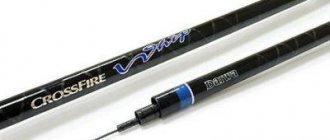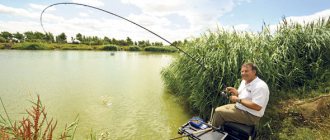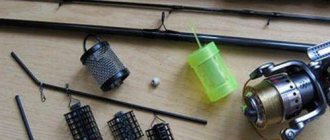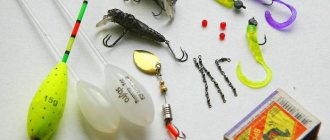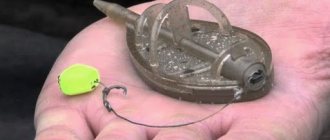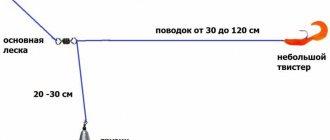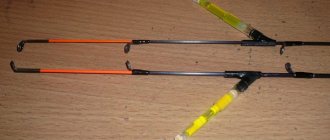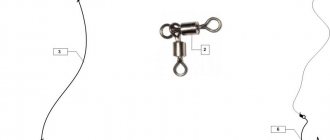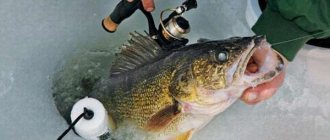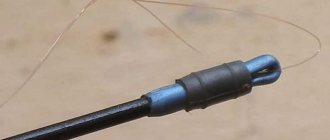Yuri 11/13/2020 2327
The method of catching trophies on a match rod is determined by the design of the corresponding float - this is a fundamental element of the tackle. Since match fishing involves casting over a long distance, it is necessary to choose the right float. Their appearance is similar to a dart, characterized by an elongated body and an elongated tail. Thanks to this shape, excellent aerodynamics are achieved during the casting process. A float for catching a match has an average length of 25-35 cm.
The most common among Astrakhan fishermen is the Wagler float for match fishing.
Description of the fishing rod, general characteristics of the tackle
A type of float tackle, adapted for comfortable fishing from a long distance, 20 - 80 m, is called a match rod. Anglers hunt at the limit of visual detection of the float, which is not possible when fishing with a conventional rod. The fishing rod, invented in England, retained the main features laid down by its inventors.
Simple-looking match fishing hides nuances and a special technique of application.
It is recommended to fish with this type of fishing rod in water areas with standing water or weak currents. Most often, matcha is used when fishing from the coastline of ponds, bays, and small rivers. A variety of match fishing rod rigs allow you to hunt the inhabitants of freshwater bodies, predatory and peaceful.
With the correct selection of bait and the use of specially designed floats for matches, the baits are immersed to different depths.
What does it consist of?
The general principles of assembling matches are similar to the flywheel, Bolognese design. Installation components are classified as standard elements that are available for purchase. When choosing components, you need to rely on the rules that ensure long casts and sufficient immersion of the bait.
Rod
Modern matches are made with blanks 3.5 - 5.2 meters long. Fiberglass fishing rods are low cost, easy to maintain, and are popular among fishermen for their flexibility and strength. But a serious drawback is the heavy weight of the rod and low sensitivity.
Blanks made of high-modulus carbon are lightweight and subtly responsive to bites, but the material is fragile and requires special storage conditions.
Rods made of composite materials with the addition of carbon fiber and fiberglass are considered practical tools.
An important factor for choosing a match tool is the structure (the peculiarity of the bending of the fishing rod under a certain load):
- fast, super-fast action is justified for fishing in open waters, where nothing interferes with throwing the tackle (the upper knee or the tip of the blank bends);
- a slow action is necessary for a wide swing on reservoirs with overgrown banks (bends evenly);
- a medium or combined system (the upper part bends) will allow you to fish a large part of the water area.
The choice of formation is related to the fishing conditions and affects the technique of casting the tackle.
Types of tuning
The test load of a match rod influences the choice of bait. Light class fishing rods require small baits. Trophy specimens are caught with heavy spinning rods with a casting weight of 100-150g.
A large number of guide rings optimally distribute the load and ensure rapid slipping of the line when casting. A special feature of a match rod are high ring legs made of ceramic, sometimes with the addition of zirconium. Long legs prevent the line from touching the blank. This factor and high-quality material reduce the friction force, thereby extending the service life of the thread. The number of rings is determined by the length of the form.
It should be noted that the large number of rings is a factor due to which the matcha is confused with a Bolognese rod. The second variety is intended for fishing in water areas with current.
Matches are presented in the form of plug-in or sliding structures. A telescopic tool has fewer passage rings, it is more fragile, since the knees often dry out, the rings are fixed less firmly than those of plug forms.
Tele match rod
Solid fiberglass fishing rods are heavy and durable, but they are designed for passive fishing when the tool is mounted on a special stand. In general, the type and size of a match fishing rod must correspond to the angler’s skills and fishing conditions.
An important element is the rod handle. A structural part that provides comfort is often made from natural wood, cork, or microporous rubber. Many people prefer cork due to the pleasant feel and durability of the material, but this issue requires a purely individual approach. The best float rods.
Coil
The classic choice of a reel for a match rod is based on the preference for a spinning model equipped with a spool with a capacity of up to 200 m of fishing thread.
A matcha reel is better in a lightweight version, without additional mechanisms that make the structure heavier.
The optimal weight of the reel is 250-300 g. A model marked 1500-2500 units is suitable for any fishing conditions, which will provide the necessary supply of cord.
Spinning reel for match fishing rod
Reliable operation of the mechanism will be ensured by the presence of 3-5 bearings. A larger number will complicate maintenance and increase the time spent on fishing. The gear ratio is considered suitable 5-7. The location of the friction brake is considered preferable to the front; its fine adjustment is important.
fishing line
The choice is based on preference for a special series for match rods. Monofilament is characterized by high strength, dark colors, and negative buoyancy. The specific density of threads good for matcha is higher than the density of water, so that after splashing down the equipment, the fishing line immediately goes into the water column and does not remain on the surface.
The sensitivity of the equipment is ensured by low memory, average rigidity of the fishing line, and low stretch coefficients.
The thickness of the fishing line is related to the casting distance:
- distance up to 30 meters – thickness 0.12 – 0.16 mm;
- distance over 50 meters – cross-section 0.18-0.22 mm.
The thread for the leashes is selected thinner than the main line. Braid is not used in matches, as it sinks worse and noticeably wears out the guide rings.
Popular brands in the range of fishing lines:
- Colmic.
- Milo.
- Maver.
- Shimano.
Dark fishing line for match
The color range of monofilament will suit you in the range from light beige to gray-black shade. Sometimes a transparent version of the thread is selected.
Float
The selection of a technological product is based on the following characteristics:
- spindle-shaped float;
- length 20-30 cm;
- a long antenna of one-piece construction or with interchangeable tips for selecting color and length, which allows you to obtain stable visibility in any conditions (waves, ripples, insufficient, excessive illumination);
- built-in load consisting of washers of different weights, which is convenient for adjusting the weight.
Match floats are also called wagglers.
Before purchasing, it is recommended to study the information about the product reflected on the surface: the mass of the built-in load, the optimal weight for the working position.
The best floats for match fishing among the brands Colmic, Maver, Milo, Cralusso.
Waglers
You can make a match float from foam plastic yourself. The antenna will be rods made from plastic handles and bamboo skewers. The loading is made external - a couple of pellets are attached to the eye.
Loading
Match installation necessarily includes a load, or a set of weights, which are distributed in various combinations. Weighting is carried out with lead pellets of various weights, so that possible movement requires effort. Special slots for fishing line on the sinkers are designed for clamps. A more gentle way of fastening, without damaging the fishing line, is a special device.
The weight serves as ballast for long casts and gives the float a stable position that is sensitive to bites.
Weights are selected taking into account the weight indicated by the corresponding numbering.
In match gear, sliding sinkers are practically not used due to the occurrence of overlaps after casting and the difficulty of replacing if necessary. Blind installation prevents the equipment from getting tangled.
Leash with hook
Any match installation includes a leash with a hook. It is recommended to attach it to the main line with a small swivel, which prevents the bait from twisting and rotating during reeling. Suitable leash thickness is 0.10 – 0.12 mm. The length is chosen based on the fishing conditions, 10 - 50 cm. The size of the hook must correspond to the dimensions of the intended trophy.
The requirements for hooks are as follows:
- sharpness - to check, the tip of the sting is drawn along the nail plate. A noticeable scratch reflects a quality parameter. If the sharpness seems insufficient, then the hook is sharpened with a fine-grained file or replaced;
- strength - test the characteristic by clamping the tip in pliers and hanging weights to the eye. Durable hooks can withstand loads of up to 0.4 kg;
- the quality of hardening is checked by pressing the tip. A high-quality hook springs, but does not bend or break;
- reliable eyelet – ensures free passage of the fishing line and fixation of the knot.
The size of the hook is selected depending on the size of the nozzle.
Wagler – float No. 1 for match fishing
The Waggler float has a small cross-section in its structure, which increases the sensitivity and stability of the float. It is desirable that the body of the float itself be made of granulated cork, expanded and bound when heated - cast. Such a body is durable and, despite various injuries, retains its original appearance and continues to serve.
In a match float, the main element, in addition to the body, is the antenna. Preferable colors are black, white, and bright orange. Mixing these colors is also acceptable. These antennas are made, for the most part, from the tail feather of a peacock.
A modern waggler already has a weight built into the body . It includes 2 types, these are constant (cannot be adjusted) and variable (if necessary, changes the weight of the match float). In a variable load waggler, you can change the weight using washers that can be removed and put on. They are fastened with a screw at the bottom of the float body. For this purpose, a container that is hollow inside is also used, into which, if necessary, you can pour water or put lead shot and thus regulate the load.
Many match fishing floats are marked . This marking consists of numbers (example addition). The numbers show the specified weight of the load when floating (This is the first number) and how many grams are allowed to be added to the line (the second number). For example, "10+4".
Beginners often use an unloaded float for match fishing. It is designed for a distance from 0 to 15 m. But the most effective match float should change its load, this allows for weight adjustment and selection of suitable equipment for a variety of fishing conditions.
There are separate models of floats for match fishing, which have other auxiliary parts:
- Auxiliary antennas (they help expand the coverage area of the float, making it possible to adapt to all sorts of fishing positions),
- Regulators glued into the antenna.
Where and what kind of fish are caught with matcha
Using a match rod, you can cast as far as possible with a light float rig and confidently land fish. Suitable bodies of water for match fishing are:
- large reservoirs;
- ponds;
- flowing lakes;
- river bays
A correctly selected class of fishing rod is aimed at a specific type of fish. To catch carp, carp, and fairly large fish, special hard carp matches are used. Catching pike perch and pike is problematic due to the sharp small teeth of the predator, the bites of which cannot be withstood by a soft monofilament line. In match fishing you can catch peaceful fish:
- bream;
- roach;
- crucian carp;
- bleak;
- silver bream
Catching roach for a match
Installation of equipment
Among several types of equipment, the choice is based on the fishing depth. A simple classification is based on the way the float moves along the thread:
- sliding – for diving over three meters, i.e. longer than the length of the form. The fishing line with weights easily slides through the eye, then the stop knot will stop the movement;
- deaf - for diving up to three meters. The float is secured by a connector in such a way that it can only be moved with force or after disassembling the fastening unit.
Sometimes in shallow waters, anglers prefer the sliding method of rigging due to its sensitivity to bites, which increases the chances of catching shy fish.
Sliding equipment
Nozzle for slowly lowering to the bottom
The smooth lowering of the nozzle allows you to attract fish from the upper horizons, not only bottom dwellers. The blind fastening is combined with the location of the main load in the upper part of the insert; several small pellets (pods) are installed directly above the leash or slightly higher.
The bait will be able to stay in the water longer if the feeder is raised higher.
When using sliding equipment, the power of the float is usually increased, the weight of the load is increased to 5-7 g, and the connector is replaced. The locking knot is knitted higher, the silicone knot lower. This option is called the “Italian slider”. If you place three pellets above and distribute small weights over the insert, you get an “English slider.” The disadvantage of this assembly is the displacement of the bait from the strong current, which entails re-casting the gear.
Quick lowering attachment
Bottom fishing is aimed at a large trophy. Rapid lowering occurs when the weight is shifted towards the leader, removing the dimensional weights. At great depths, a sliding leash is used.
The selection of a suitable option is made subject to:
- fastenings with swivels to prevent the line from twisting;
- blanks of several options for inserts with sinkers for efficiency in changing fishing conditions;
- installing a silicone stopper or a piece of cambric when using sliding weights.
Installation of equipment requires certain skills. Beginner fishermen are advised to write down the sequence of actions.
Fishing CIS
Match fishing is quite difficult to master, but it allows you to catch fish at a great distance from the shore. In this article we will look at the main types and purposes of floats for match fishing.
Match gear consists of a rod from 3.9 to 4.5 meters, they are equipped with a reel with a high gear ratio. Match fishing can be divided into 2 main types depending on what kind of float we use for fishing - it is either a sliding float or with a fixed attachment point on the fishing line. Also, floats are divided by weight, if we fish at a great distance from the shore - we use heavy floats, and use lighter ones near the shore.
The first type of floats that we will consider are sliding floats or sliders; fishing with them requires some skill.
A slider is a float with a lower attachment point that is not rigidly fixed to the fishing line. Once in the water, it slides along the fishing line and stops at a stop knot that marks the depth to which the equipment is delivered to the fish. Floats for long casting and for fishing at great depths, quite impressive in size and with a large carrying capacity. They indicate the weight of the load that the float can lift. Most companies for sliding floats indicate the weight that is in the main load of the float and the weight that should be placed on the line. Most often, floats with a carrying capacity of 8 to 20 grams are used for sliding fishing.
Now let's move on to floats rigidly fixed on the fishing line, which, unlike sliding ones, are rigidly fixed on the fishing line. Such floats have a weight in the body, the weight of which is indicated on the body of the float. It consists of several washers that can be added or removed, each of these washers has a certain mass. The entire loading block must be equal to the weight indicated on the float. Each puck can weigh 2, 4 or 6 grams. What is it for? There are situations when 2 grams on the line is quite enough to sink the equipment and no small fish grabs it along the way, while the sensitivity of the float is quite high. But when you need to speed up the lowering of the equipment to the bottom, the load on the line can be increased by removing several washers. Let’s say we remove 4 grams from the float and we have a weight weighing 2 grams on the fishing line, then we must move the mass from the float to the fishing line, respectively, there should be 6 grams on the fishing line. Thus, by adjusting the speed at which the bait falls, we can tune in to a specific type of fish.
So, how is it necessary to load a float with a fixed attachment point? There are no special differences in the loading of match floats with a fixed or sliding attachment point; 1.5 - 2.0 cm should remain above the water. If a float with its own weight is designed like this, that when lowering it into the water, it will load in the middle of the rod, or under the float antenna, in which case it is enough to load it with 1-2 pellets. The smaller the float is used, for example, 8+1 or 5+0.5, the less number of pellets we can put on the main line. It can be achieved that by increasing the number of washers in the main load of the float, the float can be fully loaded without weight on the fishing line, leaving only the possibility of loading with a small pellet - a grapple. Such rigs will fly well and practically not get tangled in flight.
Floats with a fixed attachment point have a special adapter that is attached to the float through a swivel; it should rotate well. The adapter is a fairly simple device - it is a stick with two silicone cambrics. The line is passed through one cambric, wrapped around an adapter, passed through the second and fixed on a carbon stick. Such equipment will be very rigidly fixed to the fishing line, and the depth will never be lost.
When choosing floats, first of all you should pay attention to its coating, since often, even in some very reputable companies, the quality of the coating leaves much to be desired. It peels off, the antenna cracks, and the floats begin to take on water.
The next thing you need to pay attention to is the choice of antenna. Floats must have a replaceable antenna; it must be clearly visible from a great distance. The most universal antennas have a thickness of 0.3-0.5 mm. Wide antennas can only be used in calm weather, when there is no strong side wind; it is also very difficult to fish with such antennas while maintaining their integrity, because awkward movement very often leads to their loss.
Another antenna option is a very thin one, practically corresponding to floats for fishing with fly rods and plug rods, which can be used over long distances only if a person has very good eyesight and when very careful fishing is taking place. Very often, thick antennas do not always indicate a bite and only thin antennas can give out very light touches of white fish.
And the last type of antennas that are used are antennas on a carbon leg, they appeared on sale not so long ago. They are very good to use when fishing takes place in difficult conditions, a strong side wind is blowing and it is necessary to show the voles not only the sinking, but also the bites that occur on the rise and fall. This antenna allows you to see the rise of the float while using a very small pellet, which scares the fish less.
The principle of choosing the color of the antennas is to illuminate the reservoir; if the water is dark, then floats with a bright dark green color are very clearly visible. If the water has slight reflections, then it is good to use black antennas. But the most universal color of antennas is red. However, it is better to use two-color antennas - this is effective if you load the float so that one color is located under the water and then the rising bites will be clearly visible. It is the change in color that allows you to see bites on the rise at a long distance. With bites on the utop, everything is much simpler.
The most sensitive floats are made from peacock feathers; the thickness of the feather determines the carrying capacity of the float. Floats have also appeared that allow you to change the main part of the antenna; in addition, by reducing or increasing the immersion depth of the adapter, you can adjust the load capacity of the float.
An interesting element of match floats is the plumage, in fact, these are plates at the top of the float antenna; on the one hand, it serves as a flight stabilizer, but on the other hand, the plumage can cause tangling of the equipment. The difference between a float with and without feathers is huge; the flight of a float without feathers is not smooth and very often, if the cast was performed incorrectly, the equipment gets tangled. In the case when the plumage stabilizes the flight, this is especially important at long distances, the float flies exactly like an arrow and clearly crashes into the surface of the water. A very big advantage of a float with feathers is that it shows a bite on the rise due to the fact that the feathers are clearly visible and such a bite cannot be missed.
Let's move on to the weight of the floats, as you understand, a heavy float is easier to throw over long distances. But there are situations when long casting is not necessary - floats with a very small carrying capacity are suitable for this. These floats are very versatile for fishing in shallow depths. The 3 gram float can be cast quite an impressive distance, and it has amazing sensitivity and is on par with conventional fly rod floats.
Floats with a glass body are used when the fish is very careful and wary. They do not scare away fish and are very sensitive, this is very important, for example, when fishing for tench.
We have looked at the main types of floats, this knowledge should be enough to start mastering match fishing and over time you will break all your records.
Fishing technique
The fishing location is chosen taking into account the convenience of casting gear and possible fish parking. Standard preparation is required - assembling parts of equipment, arranging a workplace, mixing bait. It is recommended to prepare the installations at home, leaving only the connections of the parts with the main line at the end.
There are several main stages in the process:
- depth measurement is carried out using a pellet attached next to the heap. The antenna will become the meter. It is better to find a depth difference, which is a promising place. To secure, unwind an additional couple of meters and mark the line with a color or knot. You can use a marker float or a special sinker. Measure with the etched fishing line until the marker floats, then also mark the fishing line;
- feeding - throwing the stored balls using slingshots. The process requires skill. The mixture needs to be dense in consistency so that the bait ball does not break on the water;
- casting must be performed with great precision and care, since the equipment includes various elements of different masses, they fly at different speeds. It is important to avoid overlaps.
After correct casting, the line is not visible; the float antenna remains above the water. The tactic of increasing the speed of lowering the tackle is to immerse the tip of the fishing rod.
Match fishing rod float
When biting, choose the moment for hooking, which is carried out by pulling the rod against the movement of the float. Fishing is done by winding the reel. It is advisable to use a landing net to prevent the line from breaking and twisting under the weight of the trophy. You can buy a fishing rod.
What functions does a match float perform?
The float for match fishing is characterized by the following functions:
- They are clearly visible on the surface and during flight.
- Even the smallest bite manifests itself in a matter of seconds.
- Delivered to the required point as accurately as possible.
- During the casting process, the bait does not fly off the hook of the rig.
- When wind and waves appear, the fishing accessory floats perfectly on the water.
The following types of structures are typical for such floats:
- Constant load. Match floats do not have the ability to change the load; therefore, any match fisherman should have several spare models in his arsenal. Fishing conditions change - the type of float on the tackle changes.
- A float that allows you to adjust the load. It is considered the most universal option - the ability to change the load and adjust it to certain fishing conditions, and select the depth.
- A match float that has no weight. Strong currents and great depths are the right time to install a float that has no additional weight.
- Attention! If we are fishing at a short distance, it is better to use a float with a thin tail. Long distances require a thick tail to be more visible on the surface of the water.
Wagler floats for match fishing
If the float is needed for long-distance fishing, then it must have the appropriate color. The market is represented by bright models specifically to increase visibility from a long distance - so as not to look at it through binoculars. Some are supplemented with a tail unit in order to fly better and reach the target as accurately as possible.
The antenna must be painted in such a color that the fisherman can see it not only during the bite, but also in flight for tracking. Bright sunny weather means using a dark antenna, otherwise the bright float will produce glare. Dark, cloudy weather calls for a brightly colored float. Some floats allow you to change the tail - put a brighter or darker color.
- Attention! Depending on the fishing conditions with a match fishing rod, each float will have different equipment. The weight that needs to be added to the float is indicated on its body.
TOP 15 Match rods
Choosing a match is a responsible, painstaking task. It is better to buy a fishing rod for long-term use from a trusted manufacturer, whose brand has been tested by the practice of fishermen. The rating of match fishing rods provides basic information about the most popular models, flagships, and top designs on the fishing market.
Mantary Elite Slider Match
The rod belongs to the middle price category with good performance indicators. The progressive structure of the matcha and the plug connection ensure successful fishing at great depths of reservoirs. The universal rod blank, made of high-modulus graphite, with an additional power reserve ensures the reliability of the tackle. Comes with a durable carrying case.
Cost from 7200 rubles.
Shimano Nexave AX Match 450 SPC
The model is made of ultra-strong graphite material and belongs to the category of expensive tools aimed at catching trophy specimens. It features phenomenal power and lightness. The whip is made of carbon with the addition of organic fiber.
From 13500 rubles
Shimano Speedmaster AX Match 450 FA
The model fits perfectly with various accessories. Works great on casts due to the structure of the blank and the unhindered sliding of the line. Shimano models are equipped with ergonomic reel seats. Suitable for fishing on lakes, reservoirs, ponds with standing water. The cork handle is protected from the negative effects of water by a special coating.
Price from 15,000 rubles.
Shimano Catana CX Match 390 Fast Action
The model is recommended for beginner fishermen. It features a fast action, installation of stainless steel guide rings, and a carbon blank. The reel seat is convenient for tactile control of bites and retrievals.
Cost from 9300 rubles.
Shimano Vengeance AX Tele Match 390 F
The model with telescopic knee joint is suitable for medium and long distance fishing. The tool is quickly brought into working condition. The carbon blank with composite additives is durable and reliable.
From 8200 rubles.
Mikado Archer Heavy Match 420
A powerful rod with a slow action and guides on low legs. Thick carbon fiber blank. The handle is straight, made of cork material. Classic reel seat. An unpretentious but reliable tool.
Cost from 4000 rubles.
Kaida Silver Hawk 3.8 m
Budget telescopic model, one of the top sellers. The advantages of the Kaida series tools are lightness, a reel seat with quick locking, and good dynamics when fishing. The blank is made of high modulus carbon.
Test up to 80 g. Cost from 1800 rubles.
VOLZHANKA “VOLZHANKA” 4.2 m
Robust, weighted design with plug-in elbow connection. The development of the Volzhanka series of rods is suitable for fishing in passing rivers. Neoprene handle, lightweight graphite composite screw reel seat. The tool is designed for casts up to 50 meters.
Cost from 2800 rubles.
SALMO SNIPER MATCH TEST 5-25 GR
A match rod from a series of inexpensive tools with a medium action, plug-in design. A durable blank made of composite materials ensures balance, range, and accuracy when casting. The rings of the Salmo models on high legs ensure good sliding of the fishing line. Neoprene handle, screw type reel seat.
Cost from 3400 rubles.
Flagman Legacy model
The rod is suitable for match fishing for small carp and crucian carp in ponds and lakes with still water. The telescopic design is equipped with 5 rings. Lightweight tool suitable for beginner hunters.
From 1200 rubles.
Model Sensor Carp Match
The match rod is quite powerful, despite its low weight. Suitable for catching crucians and carp. The model will suit both novice fishermen and professionals.
Cost from 1800 rubles.
Speddy Match
A rod with a graphite blank, lightweight guides, which ensures good balance of the tackle, and the use of thin lines. Test 5-15 gr. The match allows you to work with floats of various weights. Comfortable handle length. The design is carefully thought out for comfortable fishing.
Cost from 6000 rubles.
Mantary Match
The tool combines strength and light weight, convenient for long-term manipulations, long casts, and fishing. The cork handle fits well in the palm. The design of the match rod provides complete control at every stage of fishing and instant hooking. The delivery set includes a case and a hard tube.
Cost from 5500 rubles.
Daiwa Aqualite Power Match
Plug rod model, medium-fast action. The Power class match is equipped with 13 rings. The blank is made of carbon with the addition of carbon fiber. The comfortable cork handle of the Daiva models is reliable and durable. Case included.
Cost from 4300 rubles.
